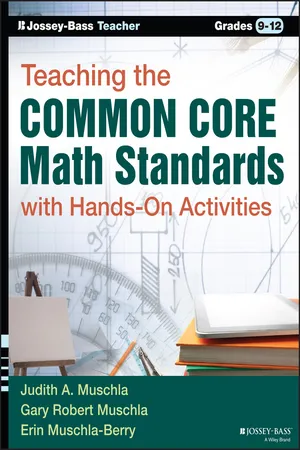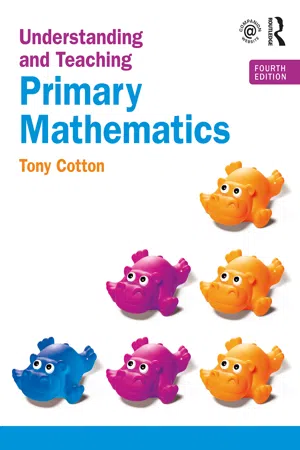Congruence Transformations
Congruence transformations in mathematics refer to transformations that preserve the shape and size of a geometric figure. These transformations include translations, rotations, reflections, and dilations. When a figure undergoes a congruence transformation, its corresponding parts maintain the same relative positions and lengths, resulting in a congruent figure.
4 Key excerpts on "Congruence Transformations"
- Gary R. Muschla(Author)
- 2015(Publication Date)
- Jossey-Bass(Publisher)
...Section 4 Standards and Activities for Geometry Congruence Congruence is a geometric relationship in which figures have the same shape and size. It can be proven using transformations that preserve distance, such as reflections, rotations, and translations. Two figures are congruent if one or more of these transformations carries a figure onto another so that the figures coincide. G-CO.1 “Experiment with transformations in the plane.” 1. “Know precise definitions of angle, circle, perpendicular line, parallel line, and line segment, based on the undefined notions of point, line, distance along a line, and distance around a circular arc.” Activity: Drawing and Defining Figures Students will draw an angle, circle, perpendicular lines, parallel lines, and a line segment according to written instructions. They will then write a definition for each figure. Materials Ruler; protractor; compass; unlined paper; reproducible G-CO.1, “Instructions for Drawing Figures,” for each student. Optional: Computers with interactive software that students may use to draw the figures. Procedure Explain that geometry is based on three undefined terms: point, line, and plane. An understanding of these terms is necessary to understand other geometric terms and principles. Although point, line, and plane remain undefined, they can be described: A point is represented by a dot. It has no length, width, or thickness. A line has only length; it has no width or thickness. A line extends infinitely in both directions. A plane has length and width. It does not have thickness. Explain that the reproducible contains instructions for drawing five figures. Students are to follow the instructions and draw the figures on the unlined paper (or use interactive software). Once they have drawn each figure, they will name the figure and write a definition for it. Closure Have your students share their drawings...
- eBook - ePub
Understanding Mathematics for Young Children
A Guide for Teachers of Children 3-7
- Derek Haylock, Anne D Cockburn(Authors)
- 2017(Publication Date)
- SAGE Publications Ltd(Publisher)
...This involves recognizing both equivalences and transformations: ways in which shapes can be regarded as being the same and ways in which shapes differ or change. The fact that these concepts of equivalence and transformation are fundamental to understanding both number and shape is one of the reasons why these two aspects of learning are considered to be two branches of one subject. Transformations that might be applied to a shape, in order of increasing distortion of the original shape, are translation, rotation, reflection, similarity, affinity (family likeness), perspectivity and topological transformation. Geometric concepts and language needed to identify and discuss transformations and equivalences in space and shape include: position, here, there, nearer, further, closer, higher, lower, above, below, in front of, behind, direction, up, down, left, right, forwards, backwards, co-ordinates, clockwise, anti-clockwise, angle (dynamic and static), right angle, a quarter, a half and three-quarters of a turn, rotational symmetry, mirror line, line symmetry, congruent, similar, scale factor, scaling up, scaling down, family likeness, parallel, polygon, side, triangle, quadrilateral, pentagon, hexagon, square rectangles and oblong rectangles, parallelogram, rhombus, perspective drawing, path, region, junction, between, next, meet, inside, outside. Suggestions for Further Reading Chapters 24, 25 and 26 of Haylock (2014) explain in more detail the mathematics of angle, transformations, symmetry and the classification of shapes. A chapter by Hejný and Slezáková entitled ‘Investigating mathematical reasoning and decision making’ in Cockburn (2007) provides an interesting range of activities to encourage classification,...
- Caryl Lorandini(Author)
- 2021(Publication Date)
- Barrons Educational Services(Publisher)
...13 TRANSFORMATIONAL GEOMETRY WHAT YOU WILL LEARN • The properties of dilations, rotations, reflections, and translations • How to describe the effect of dilations, translations, rotations, and reflections on two-dimensional figures using coordinates SECTIONS IN THIS CHAPTER • What Is Transformational Geometry? • What Is a Reflection? • What Is a Translation? • What Is a Rotation? • What Is a Dilation? • What Is Symmetry? • What Are Series of Transformations? 13.1 What Is Transformational Geometry? The word transform means “to change.” A transformation can be a change in size or location. People often think of skateboarders or figure skaters as they do flips or turns. DEFINITION Transformation The result of a change made to an object. The first three transformations are shown below. They preserve the size as well as the shape of an object. Reflection (flip): Rotation (turn): Translation (slide): All of these transformations change the location of an object, but each in a different way. These are considered rigid motions. The fourth transformation is dilation. A dilation is different because it changes the location and the size. It is not a rigid motion unless the scale factor is 1. Dilation (shrink or stretch): The vocabulary should come easy as it might be familiar to you. The original figure is the pre-image...
- eBook - ePub
- Tony Cotton(Author)
- 2020(Publication Date)
- Routledge(Publisher)
...The three transformations are translation, reflection and rotation. A translation leaves the shape’s dimensions and its orientation unchanged. In other words, it is the same as sliding the same shape across the grid. Here is an example from a Year 6 girl: This shape has moved 2 in the x direction (that is, backwards along the x-axis) and + 1 in the y direction (that is, upwards along the y axis) and so you would write: (1 − 2) A negative sign in front of the number would represent a move backwards along the x-axis or down the y-axis. A reflection transforms the shape using a mirror line, as follows: When reflecting in a mirror line, you need to take care to check that all points are the same distance from the mirror line. So, in the example, points A and B are three squares from the mirror line and C is one square away. You must always measure at right angles to the mirror line. Finally, we can rotate shapes. When we rotate shapes we have to define the point we are rotating about, called the centre of rotation, and say the angle we are rotating through. For example, if we rotate this triangle about the origin, the dimensions of the triangle will stay exactly the same. It is as if we have fixed a ‘stick’ to the corner ‘A’ and moved it through x degrees: Symmetry The use of the mirror line gives us a link into the idea of symmetry. The form of symmetry here is called reflective symmetry. The best way to explore line symmetry is through folding shapes. If you can fold the shape in half so that the pieces fit exactly on top of each other, you have found a line of symmetry. For example: A shape can also be described as having rotational symmetry. This means that you can rotate the shape and it will look the same before you have rotated the shape through 360 degrees...



